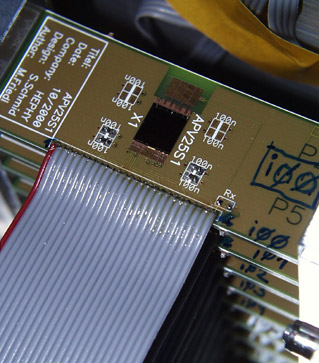



Next: Measurement Procedure
Up: APV25 Irradiation (December 2000)
Previous: APV25 Irradiation (December 2000)
Contents
A stack of eight APV25S1 chips (fig. ![[*]](crossref.gif) ) were placed in the beam focus.
The hybrid for the chips was especially designed for this test, containing no passive elements
except decoupling capacitors. This was done because the intention was to test the APVs and
not other devices under irradiation, while the capacitors were known to be radiation tolerant.
The chips had no detector connected and the stack was placed in the cooling box at an ambient
temperature of
) were placed in the beam focus.
The hybrid for the chips was especially designed for this test, containing no passive elements
except decoupling capacitors. This was done because the intention was to test the APVs and
not other devices under irradiation, while the capacitors were known to be radiation tolerant.
The chips had no detector connected and the stack was placed in the cooling box at an ambient
temperature of
 .
.
Figure:
Stack of eight APV25S1 chips in submicron technology
prepared for the irradiated in a pion beam.
 |
The APV chips were read out by the same hardware as used in module tests. For the front-end,
a special backplane board was developed to connect the eight hybrids. Clock and trigger
lines, which are normally terminated on the hybrid, were returned to the backplane and terminated
there. An external calibration line was included but finally not used because of excess
noise. An additional feature of the backplane was the possibility to monitor all supply
voltages and currents.
Some of the chips should have had their output being transmitted over a new,
radiation tolerant prototype of the analog optical link placed in the beam as well, but
unfortunately this prototype was not fully functional, such that the data were entirely transmitted
over cable.
Moreover, the PSI cyclotron system had massive problems at that time, such that only a
fifth of the targeted fluence of
 could be achieved -
nevertheless, good statistics and consistent data were obtained from this test.
could be achieved -
nevertheless, good statistics and consistent data were obtained from this test.
Apart from the APV25S1 chips, commercial digital optical transceivers, three silicon detector
modules and submicron test structures were irradiated in this beam, but their results
will not be discussed here.




Next: Measurement Procedure
Up: APV25 Irradiation (December 2000)
Previous: APV25 Irradiation (December 2000)
Contents
Markus Friedl
2001-07-14
![[*]](crossref.gif) ) were placed in the beam focus.
The hybrid for the chips was especially designed for this test, containing no passive elements
except decoupling capacitors. This was done because the intention was to test the APVs and
not other devices under irradiation, while the capacitors were known to be radiation tolerant.
The chips had no detector connected and the stack was placed in the cooling box at an ambient
temperature of
) were placed in the beam focus.
The hybrid for the chips was especially designed for this test, containing no passive elements
except decoupling capacitors. This was done because the intention was to test the APVs and
not other devices under irradiation, while the capacitors were known to be radiation tolerant.
The chips had no detector connected and the stack was placed in the cooling box at an ambient
temperature of
